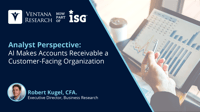Until recently, dedicated consolidation software had been a sleepy category. First introduced in the 1980s as a tool designed to run on personal computers (freeing the accounting department from reliance on its IT department), offerings basically achieved feature and function parity by the next decade. The last major technology innovation—moving the software to the cloud—began in the mid-2000s. Cloud-based software reduces the cost and complexity of ownership, making dedicated software a more...
Read More
Topics:
Office of Finance,
ERP and Continuous Accounting,
digital finance,
Generative AI,
Consolidate and Close Management
Oracle held an industry analyst summit recently where the focus was on artificial intelligence (AI) and embedded AI. At the event, Oracle demonstrated progress in adding useful AI-enabled capabilities to its business applications, especially in finance and accounting, supply chain, HR and revenue management. To put this into context, across the software industry, AI is already at work in many finance-focused applications that are currently available, albeit often in limited release. We are in...
Read More
Topics:
Office of Finance,
Analytics,
Business Planning,
ERP and Continuous Accounting,
digital finance,
Generative AI,
AI and Machine Learning,
Procure-to-Pay,
Order-to-Cash,
Consolidate and Close Management
Value-added tax is a consumption tax levied at every point in a supply chain—from production to final sale. It’s based on the difference between the cost of production and the selling price of a product or service, or the value added. Sales taxes are different in that they are generally collected only at the final point of sale to the ultimate consumer. Enterprises collect the value-added tax from customers when they sell goods or services and remit the collected VAT to the relevant national or...
Read More
Topics:
Office of Finance,
Tax,
tax compliance,
digital finance,
VAT,
Order-to-Cash,
Value-Added Tax,
Sales Tax
We’re quickly approaching the moment when it becomes clear that artificial intelligence (AI) and generative AI (GenAI) will not be free. As that happens, we will discover who’s willing to pay how much and for what. After nearly 18 months of unlimited use-case fantasizing, it should be obvious that not all the potential applications of AI can be realized over the next three to five years because they fail a cost/benefit test. In theory, AI’s potential is almost limitless, but so far, little...
Read More
Topics:
Office of Finance,
Analytics,
Business Planning,
ERP and Continuous Accounting,
digital finance,
Generative AI,
Procure-to-Pay,
Order-to-Cash,
Consolidate and Close Management
The tax provision process is an essential part of the close process and a core responsibility of tax departments. This process estimates the amount of income tax an enterprise will have to pay tax authorities in the jurisdictions in which it operates. Tax accountants derive the number by adjusting the reported net income with a variety of permanent differences, such as expenses that are not deductible and temporary differences–for example, using allowable accelerated depreciation for tax...
Read More
Topics:
Office of Finance,
ERP and Continuous Accounting,
digital finance
If you search “for want of a nail” on your browser, you’ll discover the age-old wisdom that seemingly trivial things can have a far-reaching impact. It’s a parable for artificial intelligence used in business. Deconstruct the imagined big-picture impact of AI and there are thousands of minor tasks that soon will require little or no human involvement in the interstices of an end-to-end process. Humans will still be indispensable, but they won’t be doing predictably repetitive work....
Read More
Topics:
Office of Finance,
Order-to-Cash
There have been a multitude of potential use cases for artificial intelligence (AI) and generative AI (GenAI) dreamed up over the past 18 months. ISG-Ventana Research describes AI as the development of systems and software capable of automating tasks that have previously required human intelligence. It encompasses machine learning (ML), deep learning and GenAI to deliver capabilities including predictions, recommendations, personalization, speech and visual recognition as well as translation...
Read More
Topics:
Office of Finance,
digital finance,
Procure-to-Pay
Sage Intacct recently held its annual user conference, and while there were plenty of product announcements and roadmap presentations, my focus here is on the artificial intelligence elements. AI–both predictive and generative–is the most important capability and differentiator in software aimed at finance and accounting departments. Ventana Research asserts that by 2027, almost all vendors of ERP software will incorporate AI to reduce workloads, speed processes and decrease errors.
Read More
Topics:
Office of Finance,
Business Planning,
ERP and Continuous Accounting,
digital finance,
Purchasing/Sourcing/Payments,
Consolidate/Close/Report
Artificial intelligence seems poised to change everything, although naturally a great deal of attention tends to be paid to the cool things it makes possible. AI can also make the humdrum less tedious and even transform the dullest of back-office operations into something more meaningful. For example, AI can take accounts receivable automation to the next level.
Read More
Topics:
Office of Finance,
AI,
digital finance,
AI and Machine Learning,
Order-to-Cash
Zoho recently held its annual analyst day to communicate its strategy, objectives and product roadmap. The privately held company, headquartered in Chennai, Tamil Nadu, India, has an unconventional approach to the software market. Its self-described corporate philosophy emphasizes making bold moves that challenge assumptions. Its design engineering approach stresses simplicity and cost while aiming to provide easy-to-use software with sufficient capabilities to improve personal and...
Read More
Topics:
Office of Finance,
Voice of the Customer,
Digital Commerce,
ERP and Continuous Accounting,
digital finance,
Customer Experience Management,
Generative AI,
Procure-to-Pay,
Order-to-Cash



















